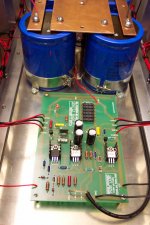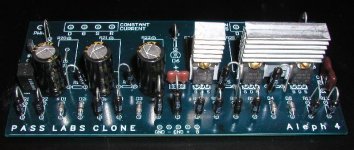Hello forum
I am spirit to build the ALEPH 2.
I shall like to know if it is necessary to isolate the standard(cannon) of the IRF 9610 to go(take) up them on heatsinks, not to put them in the ground 😎
Happy new year for all
I am spirit to build the ALEPH 2.
I shall like to know if it is necessary to isolate the standard(cannon) of the IRF 9610 to go(take) up them on heatsinks, not to put them in the ground 😎
Happy new year for all
I'm not quite sure what you mean. The fet's do not need to go on the main heatsink but should be seperate from it.
In fact ,
I put small radiators on the 9610 but I do not have to isolate the standard(cannon).
I wanted to know if it is necessary to isolate. 😎
@+
I put small radiators on the 9610 but I do not have to isolate the standard(cannon).
I wanted to know if it is necessary to isolate. 😎
@+
I think I understand now. It is good to put small heatsinks on the small fet's and you do not have to isolate them from the heatsinks, as long as they do not touch anything else.
Happy Building!
Happy Building!
then I do not know or is my problem.
I test the exit HP is I have a D.C. current.
I don't find the breakdown .
😎
I test the exit HP is I have a D.C. current.
I don't find the breakdown .
😎
Give us some voltages. Source resistors. Where is the current you are measuring? Across the output? are you using a resistor across the output? More information please. I'm finishing up my Aleph 2's also today.
I wonder how much difference it will make to mount the
IRF9610's forming the differential pair (Q1 and Q2)
back-to-back on a single heatsink for better thermal
tracking. In this case, the devices will need to be
electrically isolated.
Dennis
IRF9610's forming the differential pair (Q1 and Q2)
back-to-back on a single heatsink for better thermal
tracking. In this case, the devices will need to be
electrically isolated.
Dennis
I have use the same diagram that "Wayne" with the same value of the components. at exit I then have a D.C. current which goes up, I quickly cut off the supply.
It sounds like a thermal problem. How big are your main heatsinks and did you match your mosfets well? How are they mounted to the heatsinks?
Here is what I did for heatsinks. They are the small compact Wakefields for TO-220 cases. The 9610 current source does run warm....the input pair run cooler as they split the current supplied to them. I heatsink them anyway. The sinks are only about 30 cents from Digi-Key.
Mark
Mark
Attachments
Isolation of 9610?
Dear members,
I still do not understand one technical question:
I built the Aleph 4 and Aleph 5 using Kristijan boards.
The three IRF 9610 are placed in one line, so I could use one aluminium plate to cool them all, and also to ensure same temperature. What I don't know is whether I will have to (electrically) isolate them against one another...
Is it no problem when their metal backsides are electrically in touch with each other, or do I have to use isolation to prevent this?
With kind regards,
Lucas
Dear members,
I still do not understand one technical question:
I built the Aleph 4 and Aleph 5 using Kristijan boards.
The three IRF 9610 are placed in one line, so I could use one aluminium plate to cool them all, and also to ensure same temperature. What I don't know is whether I will have to (electrically) isolate them against one another...
Is it no problem when their metal backsides are electrically in touch with each other, or do I have to use isolation to prevent this?
With kind regards,
Lucas
Re: Isolation of 9610?
JH
I like one common aluminium plate heat sink for the three too. But, since the metal backside of IRF9610 is the same as the drain lead, each FET is to be electrically insolated by insulating washer (e.g. silicon washer).Lucas_G said:The three IRF 9610 are placed in one line, so I could use one aluminium plate to cool them all, and also to ensure same temperature. What I don't know is whether I will have to (electrically) isolate them against one another...
Is it no problem when their metal backsides are electrically in touch with each other, or do I have to use isolation to prevent this?
JH
Since the entire amp will heat up t an equilibruim temperature I don't think connecting them is at all necessary.
Mark
Mark
If keeping the same operating temperatures of transistors is a benefit, fitting them on one piece of heat sink could assure us of the benefit. If it is no benefit, we could leave them together on the same piece of heat sink, just for fun.
🙂
JH
🙂
JH
- Status
- Not open for further replies.
- Home
- Amplifiers
- Pass Labs
- Aleph 2

